Home
Toyota Takes Five, Warranty Wise.
Just days after Subaru announced they will be offering a five year and/or unlimited kilometre warranty, Toyota has joined the party. They’ve announced the introduction of the Toyota Warranty Advantage – a standard five-year manufacturer warranty for all new Toyota vehicles sold from January 1, 2019. For private buyers there’s an unlimited kilometres warranty, with commercial vehicles getting 160,000 kilometres.
Toyota also offers a 60 buy-back scheme. Owners of new vehicles are entitled to a full refund for any failure that prevents the vehicle being driveable within 60 days of collecting their new vehicles, and this 60-day money-back guarantee also applies where there have been multiple unsuccessful attempts to repair a vehicle. There is an added bonus; Toyota dealers will cover the cost of a loan vehicle and towing, if required, if a vehicle requires a warranty repair and is deemed as undriveable.

Like most companies, Toyota will now offer an extended warranty if a new car is serviced to log book specifications, of up to an extra two years. This also extends to hybrid cars and the battery systems with an extra five years and/or unlimited kilometres as long as an annual hybrid “health check” is carried out by Toyota from the fifth year onwards.
If there is a component failure due to a manufacturing defect, the coverage and apply past the Toyota Warranty Advantage period. This also covers, thankfully, Toyota genuine parts and accessories, with coverage up to five years and linked to the vehicle’s warranty coverage.

Sean Hanley, the Vice President of Sales and Marketing, said: “The Toyota Warranty Advantage demonstrates the willingness of Toyota and our dealers to provide excellent customer care that matches the enviable reputation of our vehicles for quality, durability and reliability. Our guests have told us that being able to remain on the road, with minimal disruption and inconvenience was most important to them.”
He also said: “Which is why we’ve taken the time to develop the Toyota Warranty Advantage, to ensure that we deliver what our guests are looking for – a consumer-focused warranty program that will ensure that Toyota owners feel confident and appreciated throughout an exceptional ownership experience.”
Toyota have also gone hard on capped price servicing. All new Toyota vehicles are also covered by Toyota Service Advantage, with a new Toyota HiLux costing just $180 (petrol) or $240 (diesel) for each of the first six scheduled services over three years or 60,000km (whichever occurs first). A new Toyota Corolla hybrid costs just $175 for each of the first five annual scheduled services over five years or 75,000km (whichever occurs first).
Contact your Toyota dealership for details.
Private Fleet Car Review: 2019 Suzuki Swift GL Navigator
Good things come in small packages is a phrase that’s been around forever, it seems. And never more was it an apt phrase for a car than it is for the Suzuki Swift. It’s under four metres in length, has a driveaway price of $16990, has just five gears in a manual transmission, a 1.2L engine, and 66kW. And it’s a helluva fun car to punt around. We test the 2019 Suzuki Swift GL Navigator.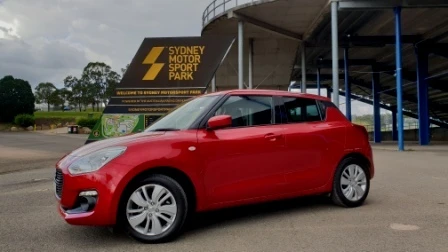 The range has been rationalised somewhat, with the Swift GL dropped and the once middle of the range Navigator now the entry level. Above that sits the Navigator with optional safety pack, GLX, and Swift Sport
The range has been rationalised somewhat, with the Swift GL dropped and the once middle of the range Navigator now the entry level. Above that sits the Navigator with optional safety pack, GLX, and Swift Sport
The car reviewed has a five speed manual and it takes a bit of getting used to. Not because it’s a manual but because there is almost no spring pressure on the gate’s mechanism. It’s limp, weak, and almost void of any real feel through the changes. That’s matched by a clutch pedal feel of pretty much the same. There’s no weight (just like the car at 870kg dry), no real pressure required to push it down.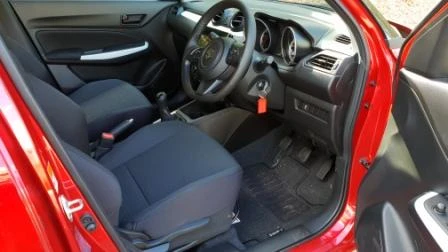 But once both are recognised for their foibles, they mesh quite well, and it really only took an hour or so to get the hang of how and where to utilise the pair in their movements. They also work well with the small engine. The 1.2L DualJet engine has just 120 torques and that comes at 4400 rpm. Simply put, it means that a bit of gear rowing is required, as is a bit of patience in regards to forward motion. The upside is economy, and Suzuki quotes around 4.5L/100km for the combined cycle. It needs to be economical as the fuel thimble holds just 37 litres. On our test the car, literally brand new at 11 kilometres on pick up, covered 300 kilometres on a half tank.
But once both are recognised for their foibles, they mesh quite well, and it really only took an hour or so to get the hang of how and where to utilise the pair in their movements. They also work well with the small engine. The 1.2L DualJet engine has just 120 torques and that comes at 4400 rpm. Simply put, it means that a bit of gear rowing is required, as is a bit of patience in regards to forward motion. The upside is economy, and Suzuki quotes around 4.5L/100km for the combined cycle. It needs to be economical as the fuel thimble holds just 37 litres. On our test the car, literally brand new at 11 kilometres on pick up, covered 300 kilometres on a half tank.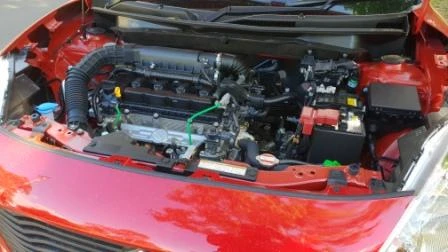 Acceleration is leisurely, at best, however once the engine reaches 3000rpm the characteristics change noticeably. There’s a change of note, urge, as it is, increases, and it feels as if it spins just a bit easier. The five speed sometimes feels as if an extra gear would be handy however considering fifth sees around 2000rpm at highway speeds, it wouldn’t have the required torque to take advantage of it.
Acceleration is leisurely, at best, however once the engine reaches 3000rpm the characteristics change noticeably. There’s a change of note, urge, as it is, increases, and it feels as if it spins just a bit easier. The five speed sometimes feels as if an extra gear would be handy however considering fifth sees around 2000rpm at highway speeds, it wouldn’t have the required torque to take advantage of it.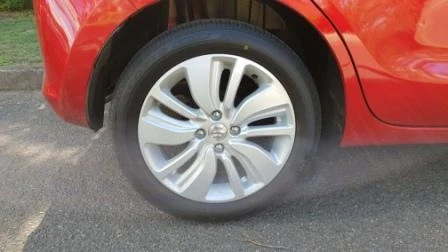 On coarse chip roads the lack of sound insulation isn’t just noticeable, it’s painful. The constant drone, and drumming, from the 185/55/16 rubber transmitted to the cabin via the MacPherson struts and torsion beam suspension, would drown out normal levels of conversation and radio, AM/FM only by the way. On the smoother blacktops it was naturally quieter and also ramped up the fun factor in the drive.
On coarse chip roads the lack of sound insulation isn’t just noticeable, it’s painful. The constant drone, and drumming, from the 185/55/16 rubber transmitted to the cabin via the MacPherson struts and torsion beam suspension, would drown out normal levels of conversation and radio, AM/FM only by the way. On the smoother blacktops it was naturally quieter and also ramped up the fun factor in the drive. 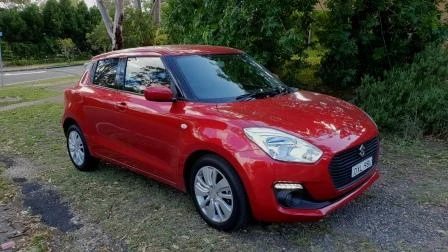 The comparatively big wheelbase, 2450mm, inside the tiny body length, 3840mm, means the Swift is very chuckable in corners, with an almost point and shoot handling style. The short travel suspension did mean some bumps crashed through, but the overall result is grin inducing…in the right hands.
The comparatively big wheelbase, 2450mm, inside the tiny body length, 3840mm, means the Swift is very chuckable in corners, with an almost point and shoot handling style. The short travel suspension did mean some bumps crashed through, but the overall result is grin inducing…in the right hands.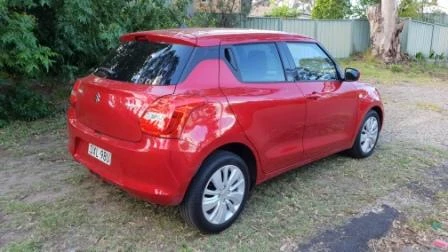 The Swift itself underwent a mild transformation externally over a year ago, with a look more akin to the Baleno thanks to pumped out tail lights and reshaped headlights. the fun factor is shown by the front end having a “smile” thanks to the horizontal lower grille and upturned corners. These house LED driving lights and bracket a wide hexagonal grille.
The Swift itself underwent a mild transformation externally over a year ago, with a look more akin to the Baleno thanks to pumped out tail lights and reshaped headlights. the fun factor is shown by the front end having a “smile” thanks to the horizontal lower grille and upturned corners. These house LED driving lights and bracket a wide hexagonal grille.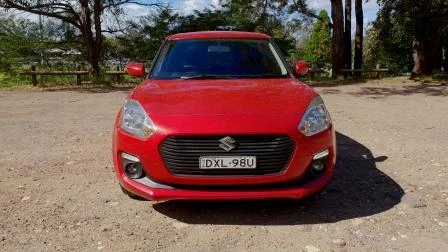 Inside it’s basic, but functional. The dash’s upper section has the Euro inspired sweep from the curve of the windscreen through to the doors, and that’s mirrored in a curve closer to the binnacle that houses a simple pair of dials and a relatively underused monochrome info screen. It shows trip and fuel consumption, and that’s it. The touchscreen is simple to use, uncomplicated in its usage, and sits above traditional dial and slide aircon controls. The audio system is moderate in quality but does have Auxiliary/USB, Bluetooth and voice control, plus Android Auto and Apple CarPlay.
Inside it’s basic, but functional. The dash’s upper section has the Euro inspired sweep from the curve of the windscreen through to the doors, and that’s mirrored in a curve closer to the binnacle that houses a simple pair of dials and a relatively underused monochrome info screen. It shows trip and fuel consumption, and that’s it. The touchscreen is simple to use, uncomplicated in its usage, and sits above traditional dial and slide aircon controls. The audio system is moderate in quality but does have Auxiliary/USB, Bluetooth and voice control, plus Android Auto and Apple CarPlay.
Safety levels in the standard Navigator GL are fine. Six airbags, standard passive driving aids, and cruise control, are a good starting point, with the Navigator and Safety Pack version adding Adaptive Cruise Control. Reverse Camera is standard across the range but the Navigator does not come with parking sensors.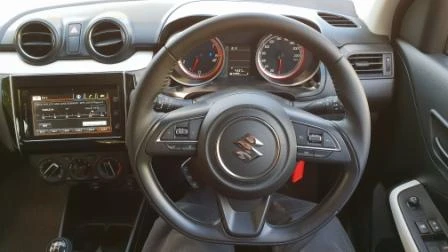 Naturally the seats are manually operated, and are comfortable enough for the price point of the Swift Navigator GL. Rear leg room is fine for near-teens but not recommended for people of six feet in height, for example. Cargo room is adequate, with a maximum of 556L with the rear sears folded. On its own, the cargo will hold almost all of a standard family weekly shop.
Naturally the seats are manually operated, and are comfortable enough for the price point of the Swift Navigator GL. Rear leg room is fine for near-teens but not recommended for people of six feet in height, for example. Cargo room is adequate, with a maximum of 556L with the rear sears folded. On its own, the cargo will hold almost all of a standard family weekly shop.

At The End Of the Drive.
As has been mentioned in our previous reviews, the Suzuki Swift is an ideal car for those getting a start in learning to drive. The basics are all in place, the safety factor is good enough to start with, and the softish clutch & shifter won’t scare a new driver. And at just on $17K it’s a good price. Above all, once the car is understood, it really is a fun machine to roll around town in. More details on the 2019 Suzuki Swift GL Navigator can be found here.
Isn't It Ioniq, Asks Hyundai?
Korea‘s Hyundai has released details of their new-to-market hybrid Ioniq. A three drive mode choice of purely electric, battery and petrol engine, and plug-in hybrid (PHEV) offer versatility in a shapely four door coupe’ style.

In the technology stakes, the car’s lithium-ion polymer bettery will charge from zero to eighty percent in around 25 minutes, with the drive range of up to 230 kilometres being available. The Ioniq Hybrid offers up to 63 kilometres on battery with the 1.6L Atkinson cycle petrol engine and six speed dual clutch auto extending that range. With the petrol engine there is peak power of 77kW, peak torque of 147Nm, and combines with the electric engine’s 32 kW / 170 Nm in the hybrid and 44.5 kW / 170Nm for the PHEV. The purely electric Ioniq develops 88kW and is rated at 295Nm.
Expected fuel economy is quoted as 3.4L to 3.9L per 100km for the hybrid and 1.1L/100km for the PHEV. The Ioniq Electric receives a charging system capable of 100kW via DC or direct current. Inside the Ioniq hybrid is a 8.9kWh battery for the expected 60 kilometres or so range, which of course depends on driving attitude and conditions. Hyundai has joined forces with JET Charge for installations of charging portals and can be sourced though the dealership network.
The Ioniqs have the proven McPherson strut front, with the Electric on a torsion beam rear suspension. The hybrid and PHEV will be on the multi-link rear. IONIQ Hybrid Elite features aerodynamic wheel covers on 15-inch alloy wheels and other variants feature a range of distinctive aerodynamic alloy wheel designs in 16- and 17-inch. Each of the three engine options can be specified in either the Elite or Premium trim levels. Any version asked for will have Hyundai’s SmartSense safety package on board as standard. The Elite Hybrid version has the IONIQ occupants protected by Forward Collision-Avoidance Assist with pedestrian detection, Blind-Spot Collision Warning and Rear Cross-Traffic Collision Warning systems. Rear view camera and park assist is also standard.
Each of the three engine options can be specified in either the Elite or Premium trim levels. Any version asked for will have Hyundai’s SmartSense safety package on board as standard. The Elite Hybrid version has the IONIQ occupants protected by Forward Collision-Avoidance Assist with pedestrian detection, Blind-Spot Collision Warning and Rear Cross-Traffic Collision Warning systems. Rear view camera and park assist is also standard.
There will be Driver Attention Warning, and Lane Keeping Assist systems fitted also. A Smart Cruise Control system completes the Hyundai SmartSense suite in every version and in IONIQ Electric this is complemented by a Stop & Go function. For the occupants enjoyment there is an eight inch touchscreen, eight speaker sound system from Infinity, SUNA satnav with ten year update allowance, Apple CarPlay and Siri voice control. Android Auto and DAB is also fitted. The Ioniq Electric has a single gear reduction driveline and, as a result, a flat floor for extra space. Regenerative braking energy recovery is standard, and can be regulated via steering column paddles. Hyundai’s standard three drive mode choices, Normal, Eco, and Sport, are standard.
The Ioniq Electric has a single gear reduction driveline and, as a result, a flat floor for extra space. Regenerative braking energy recovery is standard, and can be regulated via steering column paddles. Hyundai’s standard three drive mode choices, Normal, Eco, and Sport, are standard.
Charging wise, the Ioniq Electric comes standard with a ICCB, In-Cable Control Box, and for fast charging a commercially available charging 100kW box has eighty percent in 23 minutes or the 50kW box in 30 minutes. A 6.6kW on-board AC charger can charge the high-voltage battery in around four and a half hours when connected to a charging station of equal or higher capacity. With the installation of a personal charging station, this will allow a full overnight charge at home.
Helping with the economy figures are the lightweight body construction and adhesives. The Advanced High-Strength Steel (AHSS) is 53.5 percent of the body. Aluminuim components such as the bonnet and tailgate save 12 kilograms with the front cross-beam, front lower arms, front knuckles, rear hub carriers, and front brake calipers also in aluminuim. Exterior dimensions are 4470 mm, 1820mm, and 1450mm (L, W, H) with a wheelbase of 2700mm. Ground clearance is 150mm.  Head room is good with the Elite having front room of 994mm and the Premium with 970mm. Rear headroom is 950mm. Leg room is also decent with 1073mm for the front, 906mm at the rear. There is plenty of shoulder room with a handy 1425mm and 1396mm front and rear. Hip room is a crucial factor, and there is 1366mm & 1344 mm front and rear.
Head room is good with the Elite having front room of 994mm and the Premium with 970mm. Rear headroom is 950mm. Leg room is also decent with 1073mm for the front, 906mm at the rear. There is plenty of shoulder room with a handy 1425mm and 1396mm front and rear. Hip room is a crucial factor, and there is 1366mm & 1344 mm front and rear.
Cargo area is rated as Hybrid: 456 L, Plug-in: 341 L, Electric: 350 L to the top of the rear seats, and to the roof,
Hybrid: 563 L, Plug-in: 446 L, Electric: 455 L. Five paint colours are available across the IONIQ range – Polar White, Platinum Silver and Intense Blue Metallic, and Iron Grey and Fiery Red Mica, at a $495 cost.
Five paint colours are available across the IONIQ range – Polar White, Platinum Silver and Intense Blue Metallic, and Iron Grey and Fiery Red Mica, at a $495 cost.
The Hybrid and six speed DCT is $33,990 and $38,990, with the PHEV at $40,990 and $45,490. The Electric is $44,990 and $48,990. Prices are exclusive of dealer and government charges.
Contact your local Hyundai dealer and Private Fleet for availability on the 2019 Hyundai Ioniq.
Private Fleet Car Review: 2019 Subaru Forester 2.5-i
Subaru‘s recently revamped Forester range has four trim levels. There is the 2.5i, 2.5i-L, the Premium recently reviewed, and the top of the range 2.5i-S. Subaru is on a winner with the revamp due to the room inside, the station wagon looks, and the excellent stand list of equipment. We reviewed the entry level 2.5-i version, priced at just over $38K drive-away, directly after the Premium. Mechanically the Foresters are identical. Subaru’s much vaunted Symmetrical All Wheel Drive partners with a 90% new 2.5-L petrol engine. Gone is the diesel and at the time of writing there is a hint of late 2019 for anything hybrid. All transmissions are CVTs and come with a very well sorted seven step Lineartronic programming. The engines are all the same and the 2.5-i was driven in a more urban based environment compared to the Premium. Consumption was never over 8.0L/100km with the final figure ticking off 7.9L/100km of standard unleaded from the 63L tank.
Mechanically the Foresters are identical. Subaru’s much vaunted Symmetrical All Wheel Drive partners with a 90% new 2.5-L petrol engine. Gone is the diesel and at the time of writing there is a hint of late 2019 for anything hybrid. All transmissions are CVTs and come with a very well sorted seven step Lineartronic programming. The engines are all the same and the 2.5-i was driven in a more urban based environment compared to the Premium. Consumption was never over 8.0L/100km with the final figure ticking off 7.9L/100km of standard unleaded from the 63L tank. The X-Mode drive system is standard throughout the range. The X-Mode is a system that acts directly on engine power, all-wheel drive, torque sharing at each wheel and on the brakes.With X-Mode activated, traction control becomes more sensitive. The computer will then react faster in the event that a wheel loses adhesion. It will look at which wheel it will be best to transfer the power of the engine to get out of the most difficult situations. The downhill grip control (HDC) analyzes the situation and manages braking below a speed of 20 km / h. By applying wheel-to-wheel braking, the system will allow the driver to release the brake pedal and focus only on the best direction to take.
The X-Mode drive system is standard throughout the range. The X-Mode is a system that acts directly on engine power, all-wheel drive, torque sharing at each wheel and on the brakes.With X-Mode activated, traction control becomes more sensitive. The computer will then react faster in the event that a wheel loses adhesion. It will look at which wheel it will be best to transfer the power of the engine to get out of the most difficult situations. The downhill grip control (HDC) analyzes the situation and manages braking below a speed of 20 km / h. By applying wheel-to-wheel braking, the system will allow the driver to release the brake pedal and focus only on the best direction to take. All Foresters ride on a well proven combination of McPherson struts and coil springs up front, with an independent double wishbone rear. The entry level 2.5-i felt slightly softer in tune than the Premium, with a sense of momentarily slower rebound and an ever so slightly plusher ride. But only marginally. The Tyre Pressure Monitoring System that is standard across the range also indicated the rears to be slightly less inflated that the front, oddly enough. The ride feel may have been down to the slightly different wheel and tyre combination, with 225/60/17s.
All Foresters ride on a well proven combination of McPherson struts and coil springs up front, with an independent double wishbone rear. The entry level 2.5-i felt slightly softer in tune than the Premium, with a sense of momentarily slower rebound and an ever so slightly plusher ride. But only marginally. The Tyre Pressure Monitoring System that is standard across the range also indicated the rears to be slightly less inflated that the front, oddly enough. The ride feel may have been down to the slightly different wheel and tyre combination, with 225/60/17s. Around town the Forester turned out to need a bit more of a poke of the fly-by-wire throttle to get going. In comparison to the country driven Premium, the low end of the rev range was found wanting, This contributed to the higher fuel consumption, as it does for any car driven purely in a suburban environment. There’s a sense of lag, almost like waiting for a large, single, turbo to spool up, before the CVT bites and gets the Forester underway.
Around town the Forester turned out to need a bit more of a poke of the fly-by-wire throttle to get going. In comparison to the country driven Premium, the low end of the rev range was found wanting, This contributed to the higher fuel consumption, as it does for any car driven purely in a suburban environment. There’s a sense of lag, almost like waiting for a large, single, turbo to spool up, before the CVT bites and gets the Forester underway. In traffic it’s a well balanced machine, with steering light but not fingertip twirly. It’s weighted just enough to need a small measure of push/pull, body roll in lane changing is minimal, but the tyres chosen from Bridgestone didn’t feel as if their wet weather grip was really up to the task either.
In traffic it’s a well balanced machine, with steering light but not fingertip twirly. It’s weighted just enough to need a small measure of push/pull, body roll in lane changing is minimal, but the tyres chosen from Bridgestone didn’t feel as if their wet weather grip was really up to the task either. Each of the corners have an independent braking sensor, and the pedal is instantly responsive to the touch. It’s a confident and positive system, pulling up the Forester straight and true consistently. In conjunction with the EyeSight forward monitoring safety system and pedestrian calibrated Autonomous Emergency Braking, it’s a very safe feeling the Forester provides.
Each of the corners have an independent braking sensor, and the pedal is instantly responsive to the touch. It’s a confident and positive system, pulling up the Forester straight and true consistently. In conjunction with the EyeSight forward monitoring safety system and pedestrian calibrated Autonomous Emergency Braking, it’s a very safe feeling the Forester provides.
Naturally there are the mandated safety systems such as Brakeforce Distribution and Brake Assist, Traction Control and the Active Torque Vectoring. Subaru has fitted Swivelling Headlights to all models and that can be disabled. That’s part of the Vision Assist package which includes Blind Spot Monitor, Lane Change Assist, and Rear Cross Traffic Alert. Instrumentation isn’t that different, being largely confined to the smaller 6.3 inch touchscreen in the dash, which is surrounded by high gloss piano black, and missing out on the Driver Monitoring System that the other three receive. That’s an infra-red scanner mounted in the upper centre dash binnacle that scans the driver’s face, looking for signs of inattention and tiredness.
Instrumentation isn’t that different, being largely confined to the smaller 6.3 inch touchscreen in the dash, which is surrounded by high gloss piano black, and missing out on the Driver Monitoring System that the other three receive. That’s an infra-red scanner mounted in the upper centre dash binnacle that scans the driver’s face, looking for signs of inattention and tiredness. Interior trim is a bit more subdued than the Premium.There is less brightwork in the cabin but that’s balanced by the lighter shade of material used for the roof lining. It’s a shade somewhere between bone and cream, and enhances the otherwise austere look of the varying textures of black plastic. The seats are fully cloth covered, and have a interesting logo style pattern in the weave.
Interior trim is a bit more subdued than the Premium.There is less brightwork in the cabin but that’s balanced by the lighter shade of material used for the roof lining. It’s a shade somewhere between bone and cream, and enhances the otherwise austere look of the varying textures of black plastic. The seats are fully cloth covered, and have a interesting logo style pattern in the weave.
 The extra interior room comes courtesy of the subtle pulling and stretching of the chassis and sheet metal. The boot opening has been increased by 134mm, cargo by 78L, and floor width by 58mm. Exterior styling also loses a bit of brightwork, particularly in the lower bumper surrounds for the driving lights.
The extra interior room comes courtesy of the subtle pulling and stretching of the chassis and sheet metal. The boot opening has been increased by 134mm, cargo by 78L, and floor width by 58mm. Exterior styling also loses a bit of brightwork, particularly in the lower bumper surrounds for the driving lights. The tail gate is manually operated and houses Euro style “C” shaped lights previously embedded in the outer cluster. Polyurethane wheel arch covers and sill coverings provide both extra protection and a neutral colour to contrast the sheetmetal. Up front Subaru has given the Forester a bluffer, more upright, nose.
The tail gate is manually operated and houses Euro style “C” shaped lights previously embedded in the outer cluster. Polyurethane wheel arch covers and sill coverings provide both extra protection and a neutral colour to contrast the sheetmetal. Up front Subaru has given the Forester a bluffer, more upright, nose.
Subaru offers a five year warranty. For servicing costs, contact your Subaru dealer directly.

At The End Of The Drive.
If you’re a driver and buyer that doesn’t need bells and whistles then the entry level Forester is for you. There’s enough standard equipment such as the DAB audio, USB ports, and the driving aids. The EyeSight system and associated safety mechanisms are enough for most. To find out more about the 2019 Subaru Forester range, go here.